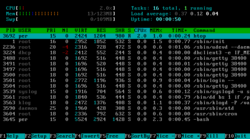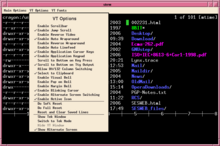
A | B | C | D | E | F | G | H | CH | I | J | K | L | M | N | O | P | Q | R | S | T | U | V | W | X | Y | Z | 0 | 1 | 2 | 3 | 4 | 5 | 6 | 7 | 8 | 9
 | |
| Standard |
|
|---|---|
| Classification | ISO/IEC 2022 based control code and control sequence set |
| Other related encoding(s) |
Other control function standards: |
ANSI escape sequences are a standard for in-band signaling to control cursor location, color, font styling, and other options on video text terminals and terminal emulators. Certain sequences of bytes, most starting with an ASCII escape character and a bracket character, are embedded into text. The terminal interprets these sequences as commands, rather than text to display verbatim.
ANSI sequences were introduced in the 1970s to replace vendor-specific sequences and became widespread in the computer equipment market by the early 1980s. They are used in development, scientific, commercial text-based applications as well as bulletin board systems to offer standardized functionality.
Although hardware text terminals have become increasingly rare in the 21st century, the relevance of the ANSI standard persists because a great majority of terminal emulators and command consoles interpret at least a portion of the ANSI standard.
History
Almost all manufacturers of video terminals added vendor-specific escape sequences to perform operations such as placing the cursor at arbitrary positions on the screen. One example is the VT52 terminal, which allowed the cursor to be placed at an x,y location on the screen by sending the ESC character, a Y character, and then two characters representing numerical values equal to the x,y location plus 32 (thus starting at the ASCII space character and avoiding the control characters). The Hazeltine 1500 had a similar feature, invoked using ~, DC1 and then the X and Y positions separated with a comma. While the two terminals had identical functionality in this regard, different control sequences had to be used to invoke them.
As these sequences were different for different terminals, elaborate libraries such as termcap ("terminal capabilities") and utilities such as tput had to be created so programs could use the same API to work with any terminal. In addition, many of these terminals required sending numbers (such as row and column) as the binary values of the characters; for some programming languages, and for systems that did not use ASCII internally, it was often difficult to turn a number into the correct character.
The ANSI standard attempted to address these problems by making a command set that all terminals would use and requiring all numeric information to be transmitted as ASCII numbers. The first standard in the series was ECMA-48, adopted in 1976.[1] It was a continuation of a series of character coding standards, the first one being ECMA-6 from 1965, a 7-bit standard from which ISO 646 originates. The name "ANSI escape sequence" dates from 1979 when ANSI adopted ANSI X3.64. The ANSI X3L2 committee collaborated with the ECMA committee TC 1 to produce nearly identical standards. These two standards were merged into an international standard, ISO 6429.[1] In 1994, ANSI withdrew its standard in favor of the international standard.

The first popular video terminal to support these sequences was the Digital VT100, introduced in 1978.[2] This model was very successful in the market, which sparked a variety of VT100 clones, among the earliest and most popular of which was the much more affordable Zenith Z-19 in 1979.[3] Others included the Qume QVT-108, Televideo TVI-970, Wyse WY-99GT as well as optional "VT100" or "VT103" or "ANSI" modes with varying degrees of compatibility on many other brands. The popularity of these gradually led to more and more software (especially bulletin board systems and other online services) assuming the escape sequences worked, leading to almost all new terminals and emulator programs supporting them.
In 1981, ANSI X3.64 was adopted for use in the US government by FIPS publication 86. Later, the US government stopped duplicating industry standards, so FIPS pub. 86 was withdrawn.[4]
ECMA-48 has been updated several times and is currently at its 5th edition, from 1991. It is also adopted by ISO and IEC as standard ISO/IEC 6429.[5] A version is adopted as a Japanese Industrial Standard, as JIS X 0211.
Related standards include ITU T.61, the Teletex standard, and the ISO/IEC 8613, the Open Document Architecture standard (mainly ISO/IEC 8613-6 or ITU T.416). The two systems share many escape codes with the ANSI system, with extensions that are not necessarily meaningful to computer terminals. Both systems quickly fell into disuse, but ECMA-48 does mark the extensions used in them as reserved.
Platform support

In the early 1980s, large amounts of software directly used these sequences to update screen displays. This included everything on VMS (which assumed Dec terminals), most software designed to be portable on CP/M home computers, and even lots of Unix software as it was easier to use than the termcap libraries, such as the shell script examples below in this article.
Terminal emulators for communicating with remote machines almost always implement ANSI escape codes. This includes anything written to communicate with bulletin-board systems on home and personal computers. On Unix terminal emulators such as xterm also can communicate with software running on the same machine, and thus software running in X11 under a terminal emulator could assume the ability to write these sequences.
As computers got more powerful even built-in displays started supporting them, allowing software to be portable between CP/M systems. There were attempts to extend the escape sequences to support printers[6] and as an early PDF-like document storage format, the Open Document Architecture.[citation needed]
DOS and Windows
The IBM PC, introduced in 1983, did not support these or any other escape sequences for updating the screen. Only a few control characters (BEL, CR, LF, BS) were interpreted by the underlying BIOS. Any display effects had to be done with BIOS calls, which were notoriously slow, or by directly manipulating the IBM PC hardware. This made any interesting software non-portable and led to the need to duplicate details of the display hardware in PC Clones.
DOS version 2.0 included optional support with a device driver named ANSI.SYS. Poor performance, and the fact that it was not installed by default, meant software rarely took advantage of it. Some other systems did try to address the need for these sequences, many clones of DOS handled them without a driver, and OS/2 had an ANSI command that enabled the sequences.
The Windows Console did not support ANSI escape sequences, nor did Microsoft provide any method to enable them. Some replacements or additions for the console window such as JP Software's TCC (formerly 4NT), Michael J. Mefford's ANSI.COM, Jason Hood's ANSICON[7] and Maximus5's ConEmu interpreted ANSI escape sequences printed by programs. A Python package named colorama[8] internally interprets ANSI escape sequences in text being printed, translating them to win32 calls to modify the state of the terminal, to make it easier to port Python code using ANSI to Windows. Cygwin performs similar translation to all output written to the console using Cygwin file descriptors, the filtering is done by the output functions of cygwin1.dll, to allow porting of POSIX C code to Windows.
In 2016, Microsoft released the Windows 10 version 1511 update which unexpectedly implemented support for ANSI escape sequences, over two decades after the debut of Windows NT.[9] This was done alongside Windows Subsystem for Linux, apparently to allow Unix-like terminal-based software to use the Windows Console. Windows PowerShell 5.1 enabled this by default, and PowerShell 6 made it possible to embed the necessary ESC character into a string with `e.[10]
Windows Terminal, introduced in 2019, supports the sequences by default, and Microsoft intends to replace the Windows Console with Windows Terminal.[11]
Description
C0 control codes
Almost all users assume some functions of some single-byte characters. Initially defined as part of ASCII, the default C0 control code set is now defined in ISO 6429 (ECMA-48), making it part of the same standard as the C1 set invoked by the ANSI escape sequences (although ISO 2022 allows the ISO 6429 C0 set to be used without the ISO 6429 C1 set, and vice versa, provided that 0x1B is always ESC). This is used to shorten the amount of data transmitted, or to perform some functions that are unavailable from escape sequences:
| ^ | C0 | Abbr | Name | Effect | ||||||||||||||||||||||||||||||||||||||||||||||||||||||||||||||||||||||||||||||||||||||||||||||||||||||||||||||||||||||||||||||||||||||||||||||||||||||||||||||||||||||||||||||||||||||||||||||||||||||||||||||||||||||||||||
|---|---|---|---|---|---|---|---|---|---|---|---|---|---|---|---|---|---|---|---|---|---|---|---|---|---|---|---|---|---|---|---|---|---|---|---|---|---|---|---|---|---|---|---|---|---|---|---|---|---|---|---|---|---|---|---|---|---|---|---|---|---|---|---|---|---|---|---|---|---|---|---|---|---|---|---|---|---|---|---|---|---|---|---|---|---|---|---|---|---|---|---|---|---|---|---|---|---|---|---|---|---|---|---|---|---|---|---|---|---|---|---|---|---|---|---|---|---|---|---|---|---|---|---|---|---|---|---|---|---|---|---|---|---|---|---|---|---|---|---|---|---|---|---|---|---|---|---|---|---|---|---|---|---|---|---|---|---|---|---|---|---|---|---|---|---|---|---|---|---|---|---|---|---|---|---|---|---|---|---|---|---|---|---|---|---|---|---|---|---|---|---|---|---|---|---|---|---|---|---|---|---|---|---|---|---|---|---|---|---|---|---|---|---|---|---|---|---|---|---|---|---|---|---|---|
| ^G | 0x07 | BEL | Bell | Makes an audible noise. | ||||||||||||||||||||||||||||||||||||||||||||||||||||||||||||||||||||||||||||||||||||||||||||||||||||||||||||||||||||||||||||||||||||||||||||||||||||||||||||||||||||||||||||||||||||||||||||||||||||||||||||||||||||||||||||
| ^H | 0x08 | BS | Backspace | Moves the cursor left (but may "backwards wrap" if cursor is at start of line). | ||||||||||||||||||||||||||||||||||||||||||||||||||||||||||||||||||||||||||||||||||||||||||||||||||||||||||||||||||||||||||||||||||||||||||||||||||||||||||||||||||||||||||||||||||||||||||||||||||||||||||||||||||||||||||||
| ^I | 0x09 | HT | Tab | Moves the cursor right to next multiple of 8. | ||||||||||||||||||||||||||||||||||||||||||||||||||||||||||||||||||||||||||||||||||||||||||||||||||||||||||||||||||||||||||||||||||||||||||||||||||||||||||||||||||||||||||||||||||||||||||||||||||||||||||||||||||||||||||||
| ^J | 0x0A | LF | Line Feed | Moves to next line, scrolls the display up if at bottom of the screen. Usually does not move horizontally, though programs should not rely on this. | ||||||||||||||||||||||||||||||||||||||||||||||||||||||||||||||||||||||||||||||||||||||||||||||||||||||||||||||||||||||||||||||||||||||||||||||||||||||||||||||||||||||||||||||||||||||||||||||||||||||||||||||||||||||||||||
| ^L | 0x0C | FF | Form Feed | Move a printer to top of next page. Usually does not move horizontally, though programs should not rely on this. Effect on video terminals varies. | ||||||||||||||||||||||||||||||||||||||||||||||||||||||||||||||||||||||||||||||||||||||||||||||||||||||||||||||||||||||||||||||||||||||||||||||||||||||||||||||||||||||||||||||||||||||||||||||||||||||||||||||||||||||||||||
| ^M | 0x0D | CR | Carriage Return | Moves the cursor to column zero. | ||||||||||||||||||||||||||||||||||||||||||||||||||||||||||||||||||||||||||||||||||||||||||||||||||||||||||||||||||||||||||||||||||||||||||||||||||||||||||||||||||||||||||||||||||||||||||||||||||||||||||||||||||||||||||||
| ^edit
If the The standard says that, in 8-bit environments, the control functions corresponding to type
CSI (Control Sequence Introducer) sequenceseditFor Control Sequence Introducer, or CSI, commands, the All common sequences just use the parameters as a series of semicolon-separated numbers such as A subset of arrangements was declared "private" so that terminal manufacturers could insert their own sequences without conflicting with the standard. Sequences containing the parameter bytes The behavior of the terminal is undefined in the case where a CSI sequence contains any character outside of the range 0x20–0x7E. These illegal characters are either C0 control characters (the range 0–0x1F), DEL (0x7F), or bytes with the high bit set. Possible responses are to ignore the byte, to process it immediately, and furthermore whether to continue with the CSI sequence, to abort it immediately, or to ignore the rest of it.[citation needed]
SGR (Select Graphic Rendition) parameterseditThe control sequence
|
